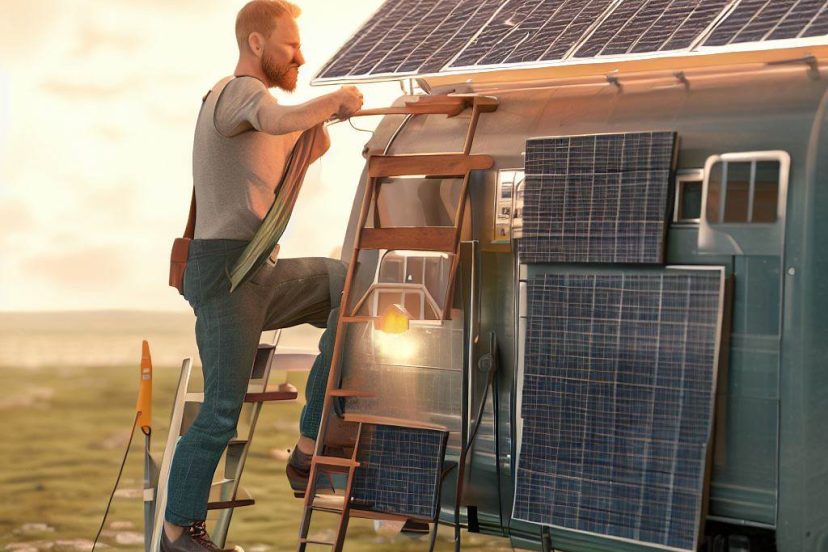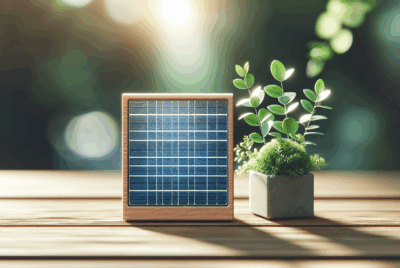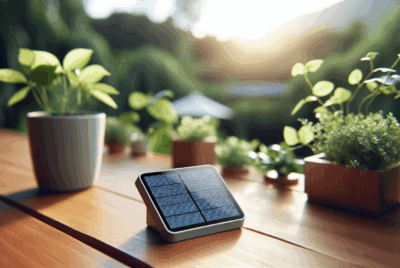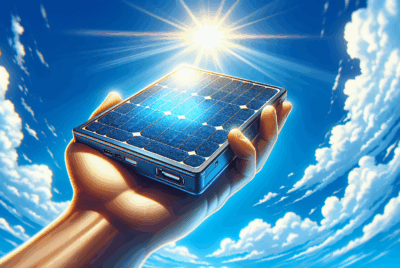Solar Panels For A Camper: A Comprehensive Guide
As an Amazon Associate, I earn from qualifying purchases, at no additional cost to you. Disclaimer
Introduction
Have you ever sat under the clear sky, surrounded by nature, with a cup of coffee in your hand, thinking about how you can make your camping trips more eco-friendly? As an outdoor enthusiast and green energy advocate, I’ve thought about it quite a lot. And the answer is clear – solar panels for a camper.
The Unparalleled Importance of Solar Panels for a Camper
If you are like me, an adventurous spirit yearning for the freedom to explore the natural world, you’ve probably realized that while nature provides an escape, we humans have certain dependencies that we can’t quite leave behind. We need to charge our phones, power our lights, and if you’re anything like me, you absolutely need that early morning coffee, piping hot, made just right in your camper’s coffee maker. This is where harnessing solar power for your camper becomes a game-changer.
On one of my earlier camping trips, I’d packed a heap of spare batteries for all my devices and a gas-powered generator for everything else. Not only was it a logistical nightmare to carry all of this extra weight around, but I also had to deal with the noise and smell of the generator, not to mention the guilt of leaving behind a large carbon footprint on the pristine environment I was there to enjoy. It was during this trip that I started thinking about cleaner and more efficient solutions.
I began researching and came across the concept of solar power for campers. It was a game-changer for me. Solar power, a renewable and abundant energy source, could provide all the power I needed without the drawbacks of my previous setup. Plus, it was a sustainable way of living in harmony with nature, which felt like the perfect way to give back to the environment that I so dearly love.
Selecting the Ideal Solar Panel for a Camper: A Step-by-Step Guide
If you’re new to solar power, choosing the right solar panel can seem like navigating through a maze. When I was in your shoes, I felt overwhelmed by the numerous options and technical jargon. But don’t worry, I’m here to simplify it for you. After much trial and error, I’ve learned a thing or two about how to choose the perfect solar panel for a camper. Here’s my advice:
Unraveling the Types of Solar Panels
The solar panel market is flooded with various types of panels, each with its pros and cons. Let’s break it down:
Monocrystalline Solar Panels: These are the most efficient, but they come with a higher price tag. They are perfect for you if you have limited space on your camper’s roof and need to maximize power output.
Polycrystalline Solar Panels: These panels are less efficient than monocrystalline panels but are more affordable. If you have ample space and are on a budget, these could be a good choice.
Thin-Film Solar Panels: These are the least efficient but the most flexible and lightweight. If weight and flexibility are your top priorities, thin-film panels could be your best bet.
I remember when I first set out to buy a solar panel, I was intrigued by the sleek look of the monocrystalline panels. But considering my budget and space availability, I eventually opted for polycrystalline panels. They might not be as efficient, but they were the right fit for me at the time.
Pondering Over Crucial Factors
Choosing the right solar panel goes beyond understanding the types. You need to consider several factors specific to your situation:
Size of Your Camper: The size of your camper will largely dictate how much roof space you have for solar panels. Take precise measurements of your available space before making a purchase.
Energy Needs: Make a list of all the electrical appliances you plan to use in your camper and calculate their energy consumption. This will give you an idea of how much power you’ll need.
Budget: Solar panels are a long-term investment. It’s essential to find a balance between what you can afford and what you need.
Weight: Remember, more weight means more fuel consumption. Always consider the weight of the solar panel system and make sure your camper can handle it.
Installation of Solar Panels
Demystifying the Installation Process of Solar Panels for Your Camper
When I first took the plunge and bought my solar panel system, I faced the somewhat scary prospect of installing it on my own camper. Let’s just say that, despite being a avid camper, I was not particularly ‘handy’. However, I soon realized that with a little research and preparation, the installation process was not as intimidating as I thought it would be. Here are some insights I learned along the way that might help you:
The Pre-Installation Stage: Planning
Before you even touch a tool, take some time to plan. Measure your camper’s roof and figure out where you want to place the panels. Ideally, they should be in a spot that receives ample sunlight and is away from any potential obstructions like antennas or air conditioners. When I was planning my layout, I used cardboard cut-outs to mimic the size of the panels and moved them around to see where they fit best.
Picking the Right Mounting Hardware
Choosing the right mounting system is essential for a secure installation. There are generally two types: fixed and adjustable. Fixed mounts are less expensive and easier to install but don’t allow for adjustments. On the other hand, adjustable mounts can be tilted to maximize sun exposure, but they’re a bit more complex to set up. I chose the adjustable mount because I wanted to maximize my solar efficiency.
The Installation Process: Take it Step by Step
The installation process may vary slightly depending on the type of solar panel and mounting system you choose. Here’s a general overview:
- First, fix the mounting hardware to the roof of your camper. Make sure they are secured properly and aligned correctly.
- Then, attach the solar panels to the mounts. Ensure they are firm and stable.
- Once the panels are in place, it’s time to run the wiring. This might require drilling into your camper’s roof to pass the wires inside. Be sure to seal any holes properly to avoid leaks.
- The wires then need to be connected to the charge controller, which should be installed in a safe, dry place inside your camper.
- The charge controller is then connected to the battery. Ensure all connections are secure and properly insulated.
During my installation process, I found the wiring to be the most challenging part, but I took my time and made sure to double-check all my connections. Eventually, I figured it out.
Safety First!
If you’ve been a part of our community for any time at all, you know I’m going to talk about safety. Remember, safety should be your top priority during the installation process. Always double-check your connections, ensure your panels are secure, and take care not to damage your camper’s roof. Don’t hesitate to seek professional help if you’re unsure at any stage. Asking for help isn’t weakness, it’s smart, especially when you know you need the help. Better to call in help now, rather than when the camper is on fire.
Installing solar panels on your camper is a gratifying DIY project, and the benefits are well worth the effort. The feeling of accomplishment when you successfully complete the installation and power up your camper with the energy harnessed from the sun is truly incredible. Just remember, it’s not a race. Take your time, do your homework, and enjoy.
Top Solar Panels for Campers: An Enthusiast’s Insightful Guide
Choosing the right solar panel for your camper can feel like an uphill task, given the plethora of options available on the market. Trust me, I’ve been there. I spent countless hours researching and comparing different panels, and I’m here to share some of my top picks to help you make an informed decision.
Renogy Monocrystalline Solar Panel
This is one of my personal favorites and a brand that has earned a reputation for its superior quality and performance. I have found that the Renogy Monocrystalline Solar Panel offers excellent efficiency and durability. It’s a bit on the pricier side, but its high power output and longevity make it worth every penny. This is an excellent choice if you’re serious about your solar setup and are ready to make a long-term investment.
Jackery SolarSaga Portable Solar Panel
If you’re just dipping your toes into solar power and looking for a portable and lightweight option, the Jackery SolarSaga might be the one for you. I’ve recommended this to many of my fellow camping buddies who love its compact design and ease of use. Although it’s not as powerful as other models, it’s perfect for powering small devices like phones and laptops during your camping trips.
Eco-Worthy Polycrystalline Solar Panel
This was my first solar panel, and it served me well. The Eco-Worthy Polycrystalline Solar Panel is an affordable option without compromising too much on efficiency. It’s a solid choice if you’re on a budget but still want to enjoy the benefits of solar power.
Go Power! Flexible Solar Panel
Are you worried about weight and flexibility? The Go Power! Flexible Solar Panel could be your answer. It’s designed to be light and flexible, making it ideal for campers with curved roofs. I remember installing this on a friend’s camper, and we were both amazed by how seamlessly it conformed to the roof’s shape.
SunPower Maxeon 3 Solar Panel
If money is no object, and you want the highest efficiency possible, the SunPower Maxeon 3 Solar Panel is a fantastic option. Known for its top-tier efficiency, this panel can generate a substantial amount of power even in a limited space. A friend who travels full-time in her camper swears by this panel. She powers everything from her fridge to her air conditioner with it!
Remember, the “best” solar panel is really personal opinion. And we all have one of those. What works well for one camper might not be the ideal choice for another. You need to consider factors such as your power needs, your budget, and your camper’s size and weight capacity. Choosing a solar panel is like choosing the right pair of hiking boots – it needs to fit you and your needs perfectly. Once you find the right one, you’ll be all set to enjoy a cleaner, more sustainable, and more independent camping experience.
Harnessing Solar Power Across the Seasons
Just like any seasoned camper knows the varying demands of each season, it’s important to understand how different times of the year can impact your solar power generation. From the summer’s high sun to winter’s short days, each season brings unique considerations for solar power use in your camper. Drawing from my experience, here are some insights:
Making the Most of Summer Sun
Summer is undoubtedly the most generous season for solar power generation, with longer daylight hours and higher sun positions. During my summer camping trips, I’ve found that my solar panels often produce excess power, allowing me to use more energy-consuming appliances like my electric grill without worrying about draining the batteries.
However, summer also brings high temperatures, which can ironically decrease solar panel efficiency. To mitigate this, try to keep your panels as cool as possible by providing proper ventilation.
Navigating Through the Fall Foliage
Fall can be a beautiful time to camp, but with shorter days and more foliage, your solar panels might not get as much sun exposure. I remember a trip when I camped under a canopy of autumn leaves. The view was stunning, but my solar power production took a big hit.
You might need to be more conservative with your power usage during fall. Consider moving your camper to sunnier spots, or if you have a portable panel, place it where it can get the most sunlight.
Wintering with Solar Power
Winter can be challenging for solar power generation due to the shorter daylight hours and lower sun position. Snow accumulation on the panels is another issue to deal with. During one winter camping trip, I woke up to find my panels covered in a blanket of snow. I had to clear it off to let the panels do their work.
During winter, orienting your panels so that they face the sun more directly can help maximize their efficiency. Also, always remember to clear any snow from your panels.
Springing into Solar Action
Spring is generally a great season for solar power with moderate temperatures and lengthening days. However, unpredictable weather and frequent rain showers might obscure the sun. During a spring camping trip, I had to weather a week-long stretch of overcast skies. It was a lesson in power conservation!
Just like fall, you might need to be flexible with your setup. Portable panels can come in handy during such times, as you can move them around to catch the sun when it decides to peek through the clouds.
Harnessing solar power for your camper across different seasons can be a bit of a balancing act. But, with each trip, you’ll become more adept at managing your solar setup.
Portable Solar Panels
For those who prefer lightweight and flexible options, portable solar panels are the way to go.
A Closer Look at Portable Solar Panels
If you’re new to the world of solar-powered camping, you might find yourself overwhelmed by the array of solar panels available on the market. As a camping enthusiast and solar power user myself, I can attest that portable solar panels are a popular choice, especially for beginners. They offer unique advantages and a great degree of flexibility. Here’s a deep dive into portable solar panels based on my experiences:
Understanding the Appeal of Portability
The key selling point of portable solar panels, as the name suggests, is their portability. I still remember my first camping trip with a portable solar panel – I was astonished at how convenient it was to handle. It’s incredibly empowering to have a power source that you can pick up, fold, and carry along with your camping gear.
Suitable Scenarios for Portable Solar Panels
Portable solar panels shine (pun intended) in scenarios where there’s limited space or the stationary solar setup isn’t feasible. Whether you’re hiking, tent camping, or just parking your camper under a shade, portable panels allow you to set them up wherever the sun is hitting.
On a trip where I parked under a tree for shade, the roof-mounted panels on my camper were of little use. That’s when my portable panel saved the day. I was able to place it in the sun, a good distance from my camper, ensuring I had a steady supply of power.
Considerations When Choosing a Portable Solar Panel
There are several factors to consider when choosing a portable solar panel:
Power: Consider how much power you need. If you’re only looking to charge small devices like phones and tablets, a lower wattage panel will suffice. However, if you’re planning to power larger appliances, you will need a more powerful panel.
Weight and Size: Since portability is the key, ensure the panel is light and compact enough to suit your needs.
Durability: Portable panels are more exposed to wear and tear, so opt for a robust and durable model.
Ease of Use: Look for panels that are easy to set up and pack away. Trust me, the last thing you want to be doing on your camping trip is wrestling with your solar panel.
Quick Tips for Using Portable Solar Panels
- Always position your panel at an angle facing the sun for maximum efficiency.
- Be aware of your surroundings. Don’t leave your panel unattended in a public campsite.
- Keep the panel’s surface clean for optimal performance.
Portable solar panels can be a great addition to your camping gear, offering you flexibility and independence. They have indeed been a game-changer for my camping adventures.
Conclusion
Choosing solar panels for a camper will not only reduce your environmental impact but also add convenience to your camping experience. But it does require energy conservation. You’ll need to minimize power usage by bringing along energy-efficient appliances and turning off devices when you don’t need them. Pretty common sense stuff. And remember to monitor your power usage throughout the day so you can avoid running out of power. Nothing will ruin a camping trip more than coming back from a long hike with plans to cook and enjoy a cold beverage, only to realize you forgot to power down and store a days worth of sun. Solar power for camping is here to stay. And with new technologies coming out, the future looks even brighter.
See you out there!
-Michael
Frequently Asked Questions (FAQs)
1. Can I use solar panels in cloudy weather?
Yes, solar panels can still generate power in cloudy weather, although at a reduced rate. Modern solar panels are designed to work in diffused light. However, the efficiency will be lower compared to bright, sunny days.
2. How many solar panels do I need for my camper?
The number of solar panels you need for your camper depends on your power usage and the size of your camper. Typically, for light use (such as charging small devices and lights), a single 100-watt panel might be enough. But for more energy-intensive uses (like powering a fridge or a heater), you might need multiple panels or a larger system.
3. What is the lifespan of a solar panel?
With proper care and maintenance, solar panels can last for 25 to 30 years or even longer. However, their efficiency may decrease slightly over time, typically around 0.5% to 1% per year.
4. Are solar panels difficult to install on a camper?
The installation process can be complex if you’re unfamiliar with electrical systems, but it’s doable with careful planning and the right tools. Many solar panel kits come with straightforward instructions for DIY installation. Alternatively, you can hire a professional to ensure a safe (yes, I said it) and correct setup.
5. Can solar panels power all my devices in the camper?
Yes, solar panels can power your devices, but the total power output depends on the size and efficiency of your solar system, as well as your energy usage. You’ll need to calculate your daily power consumption to determine if a solar setup can cover all your power needs.




